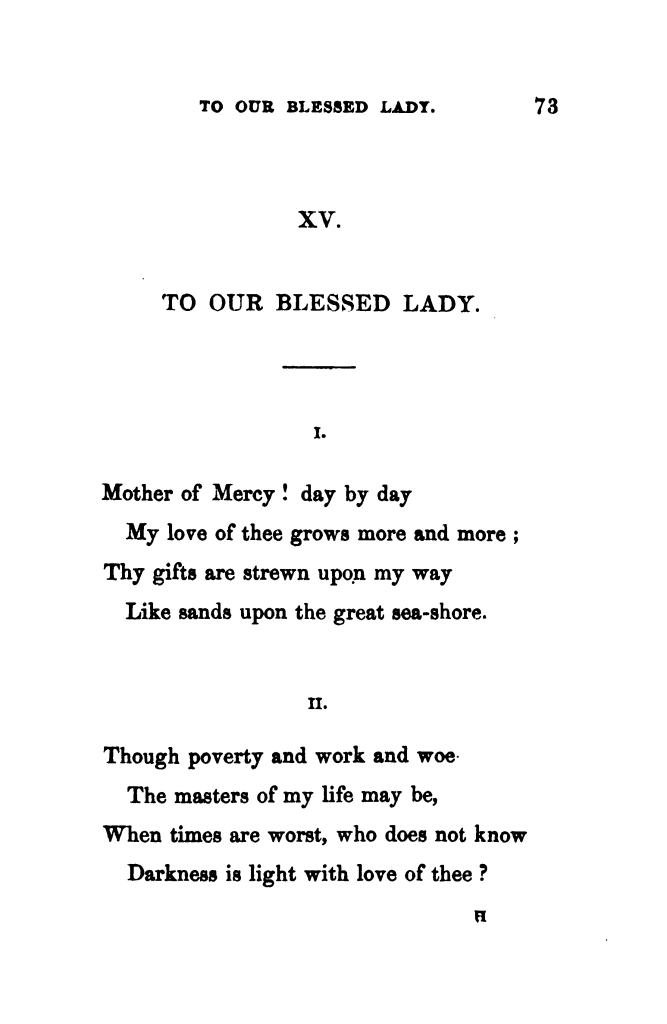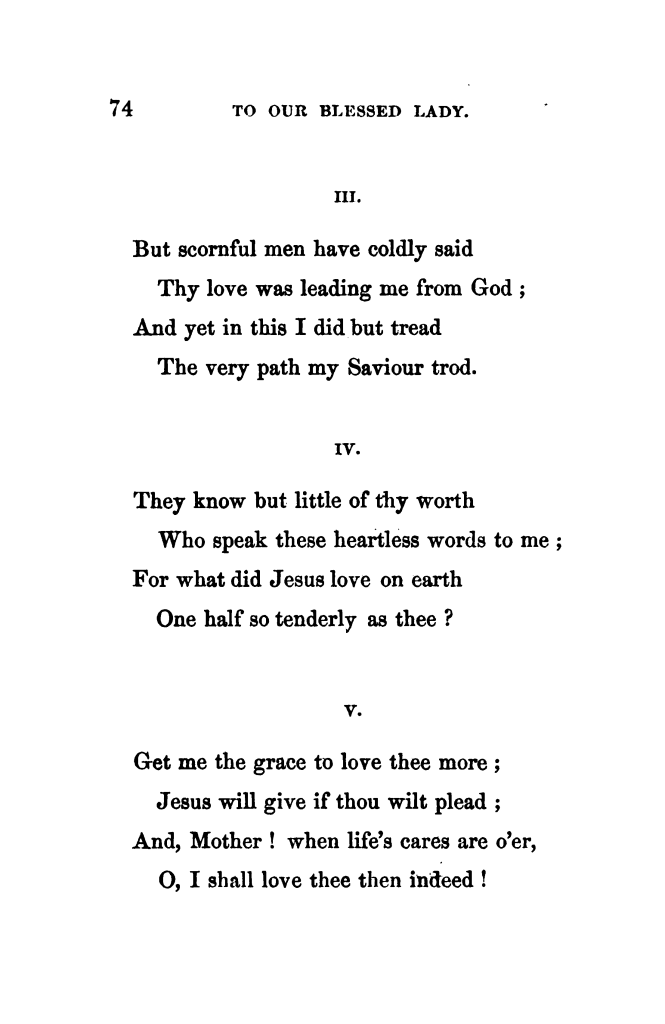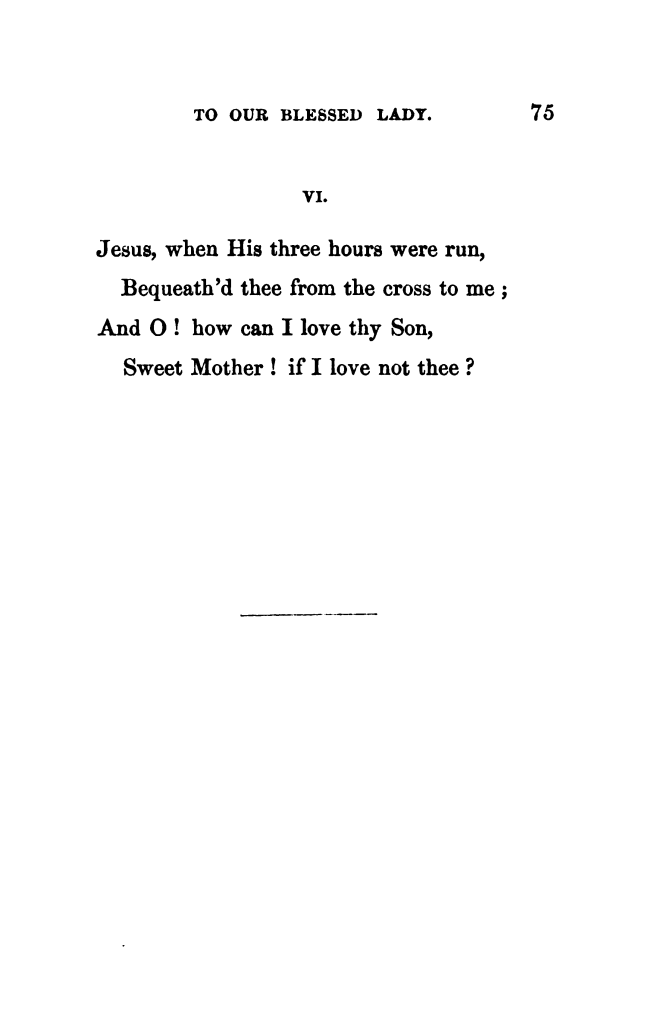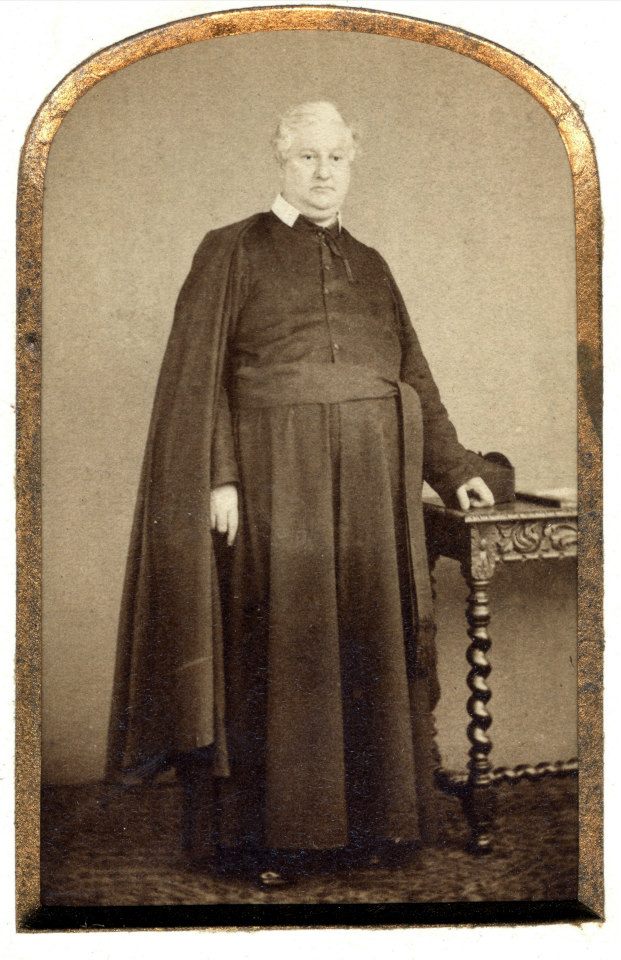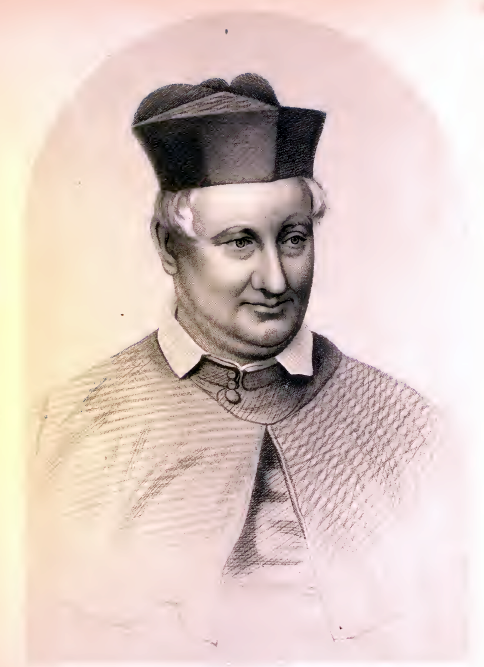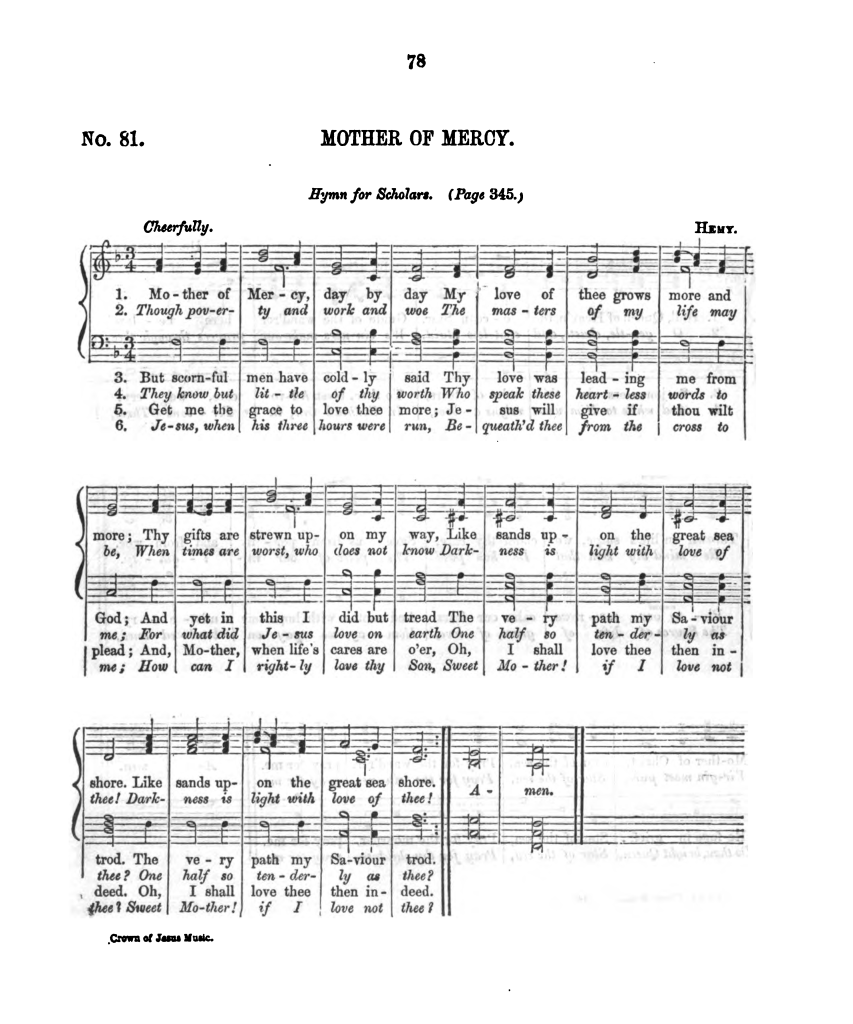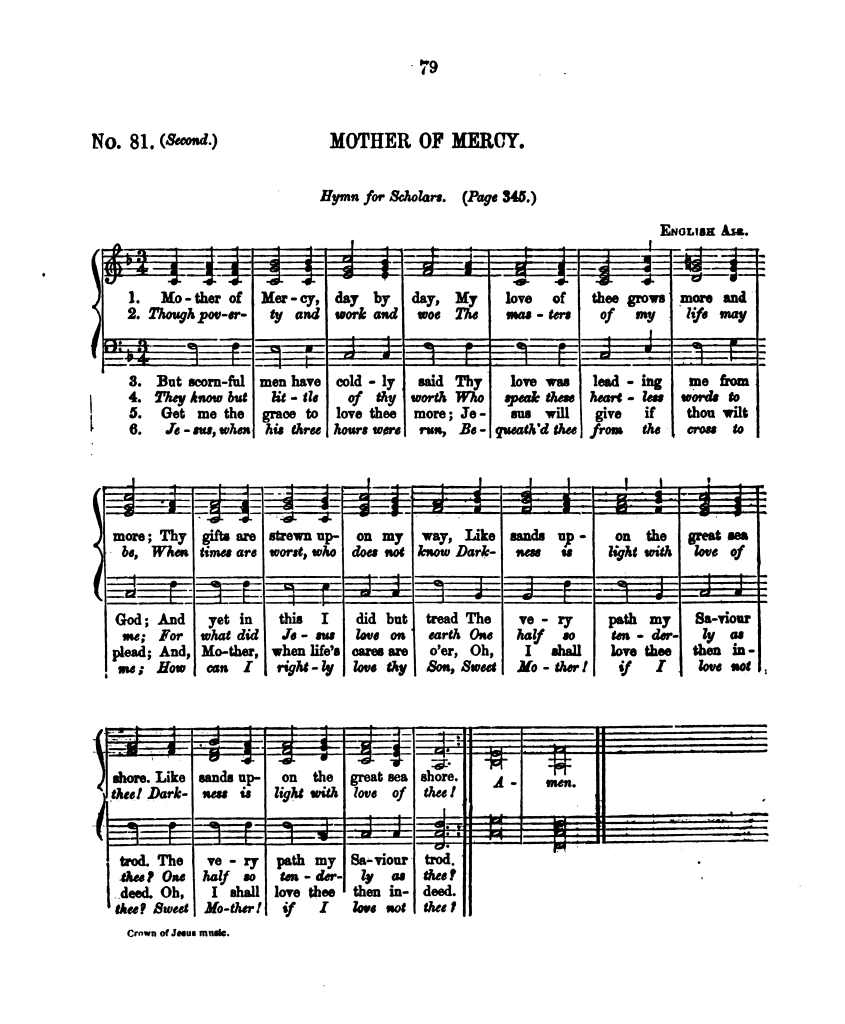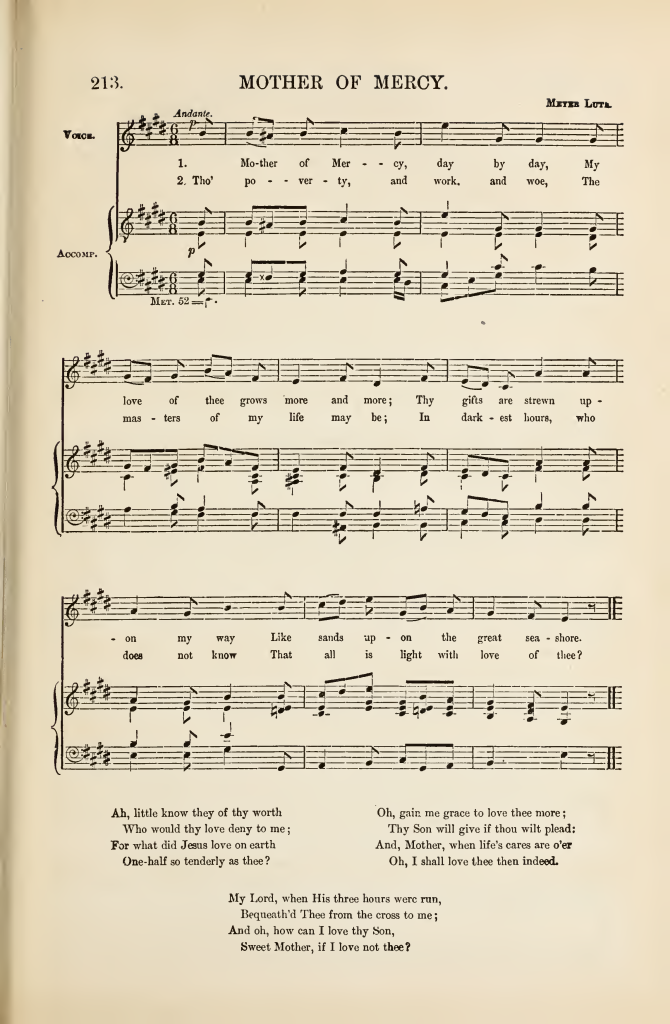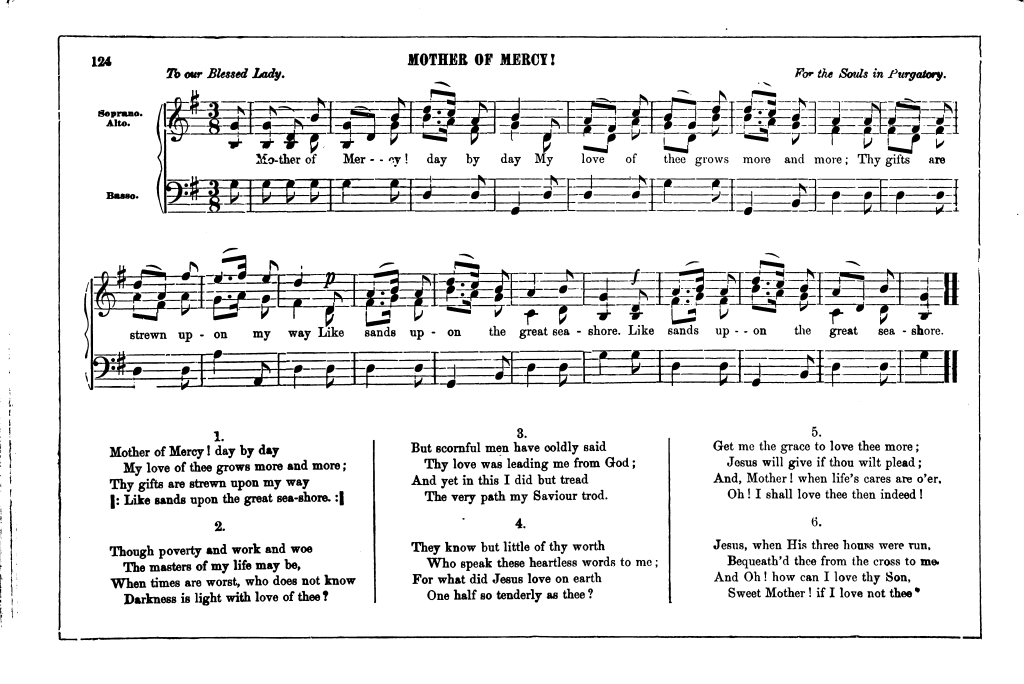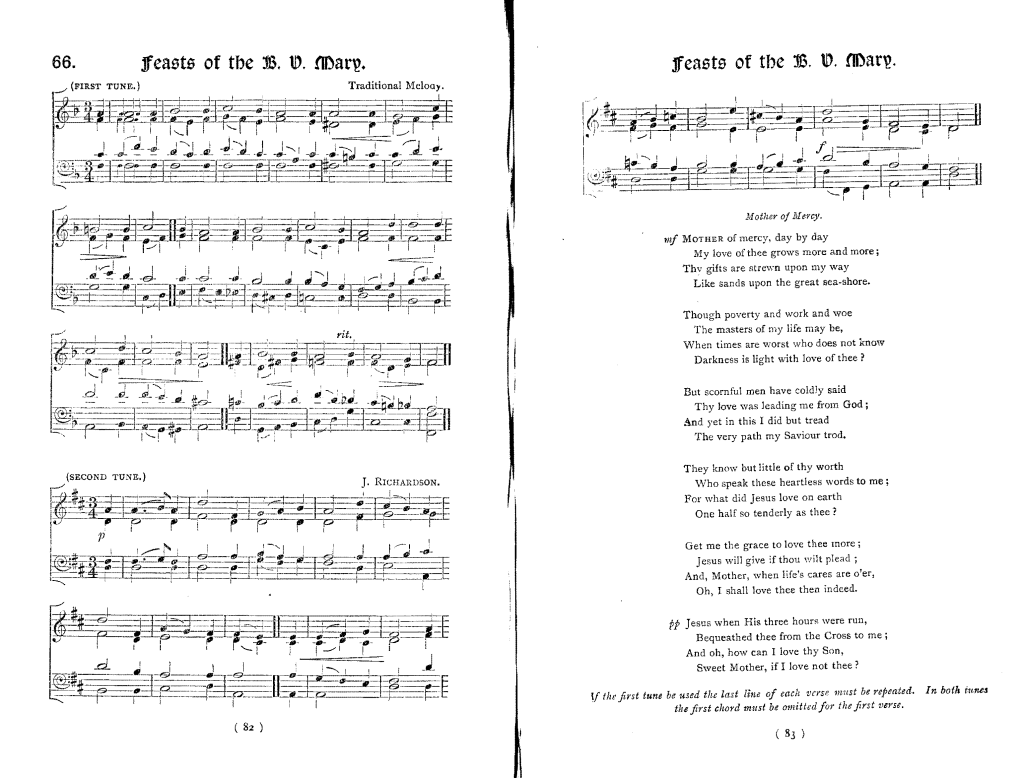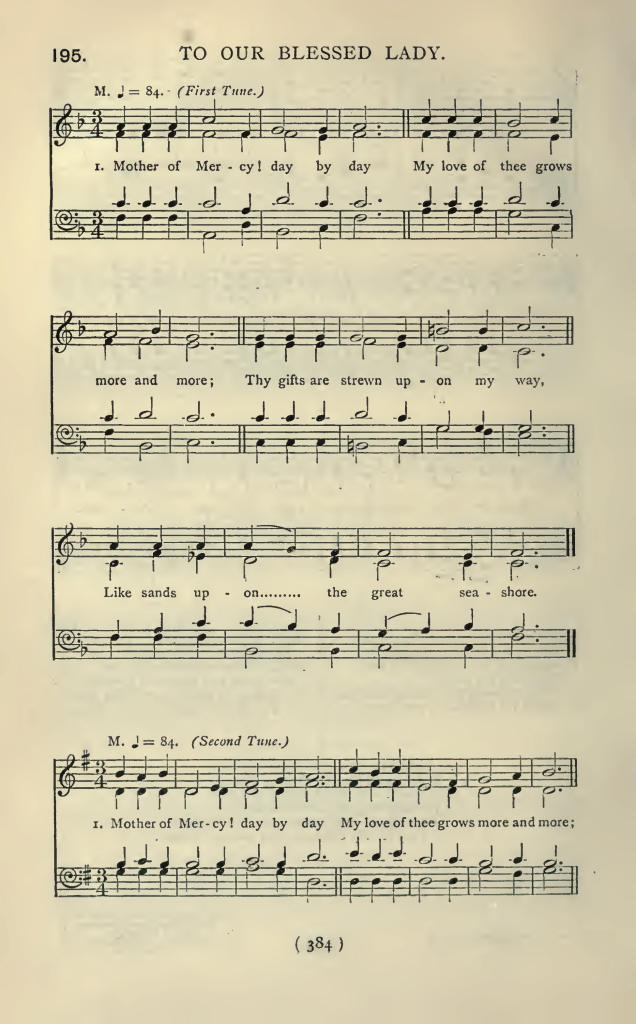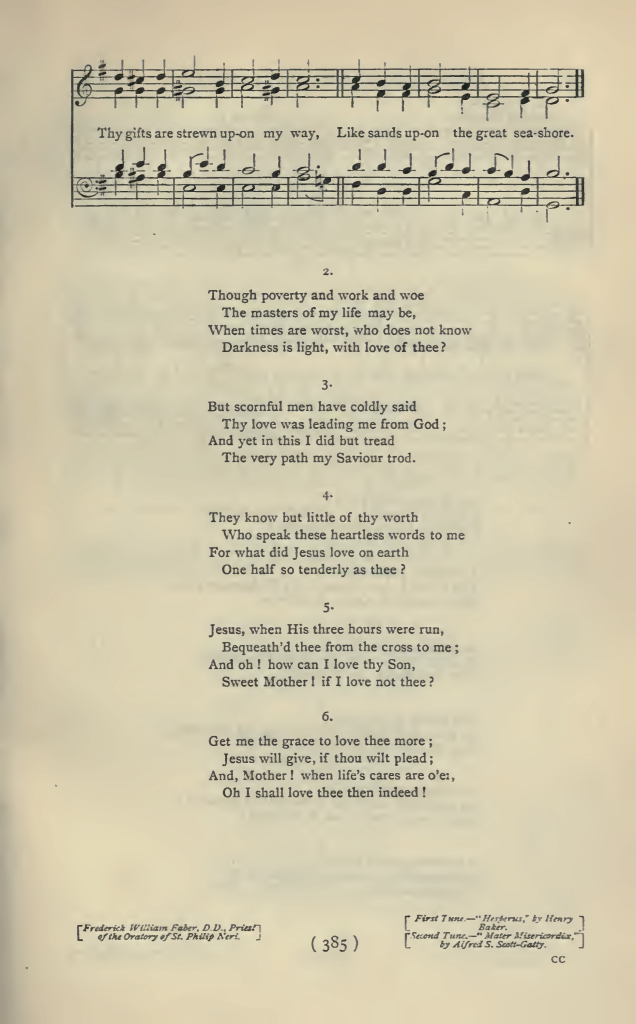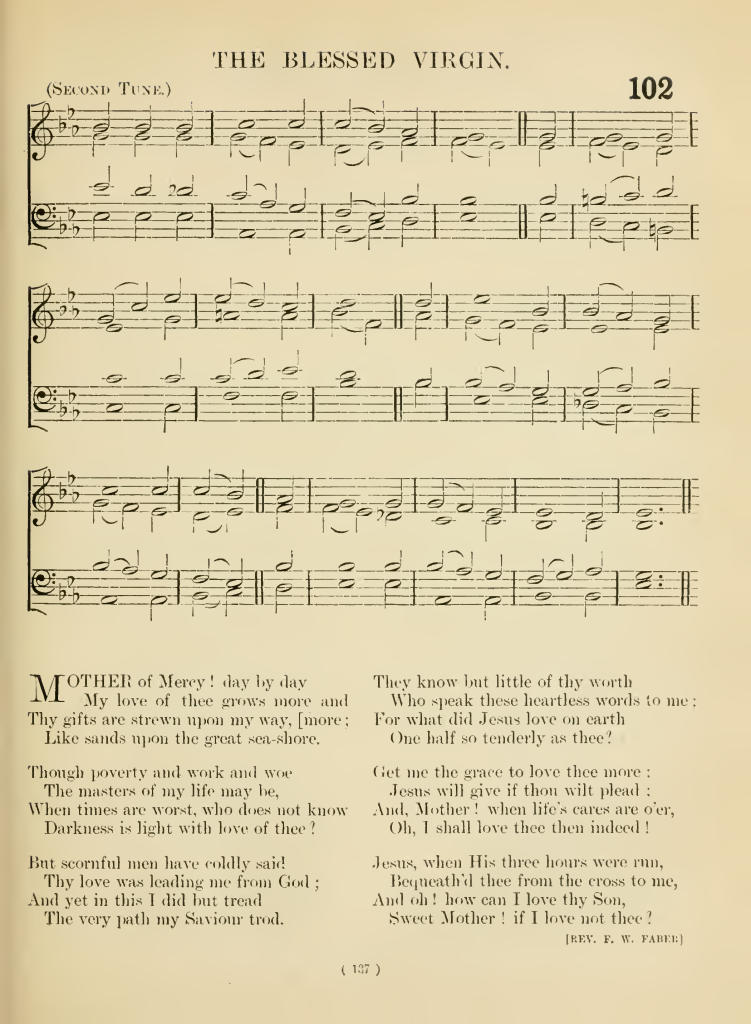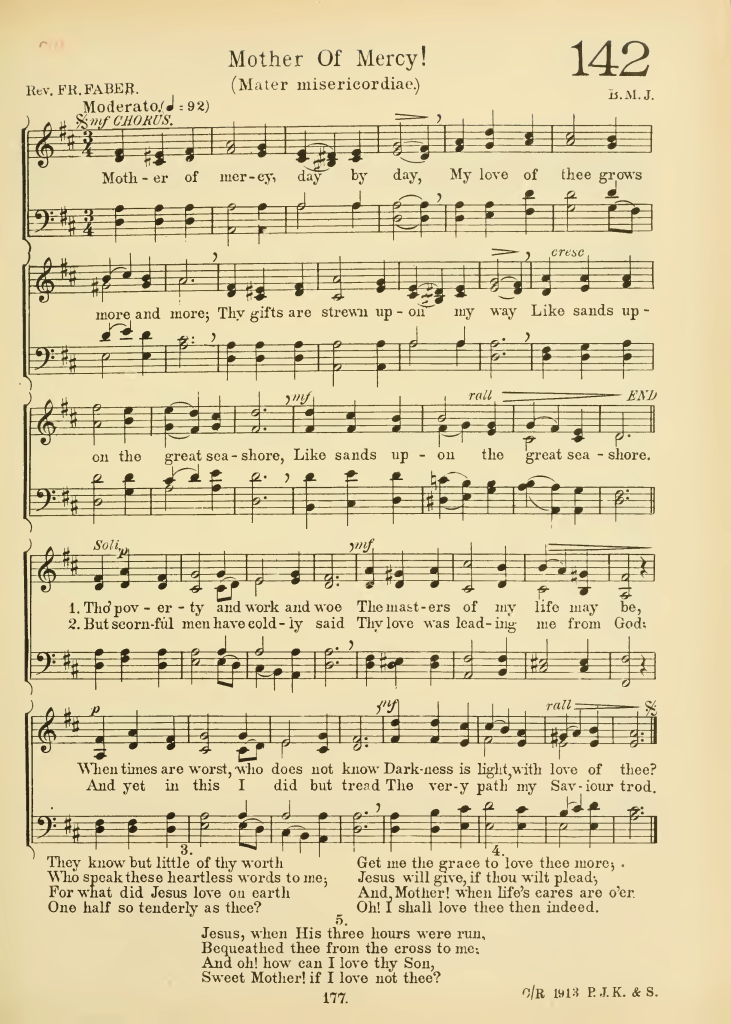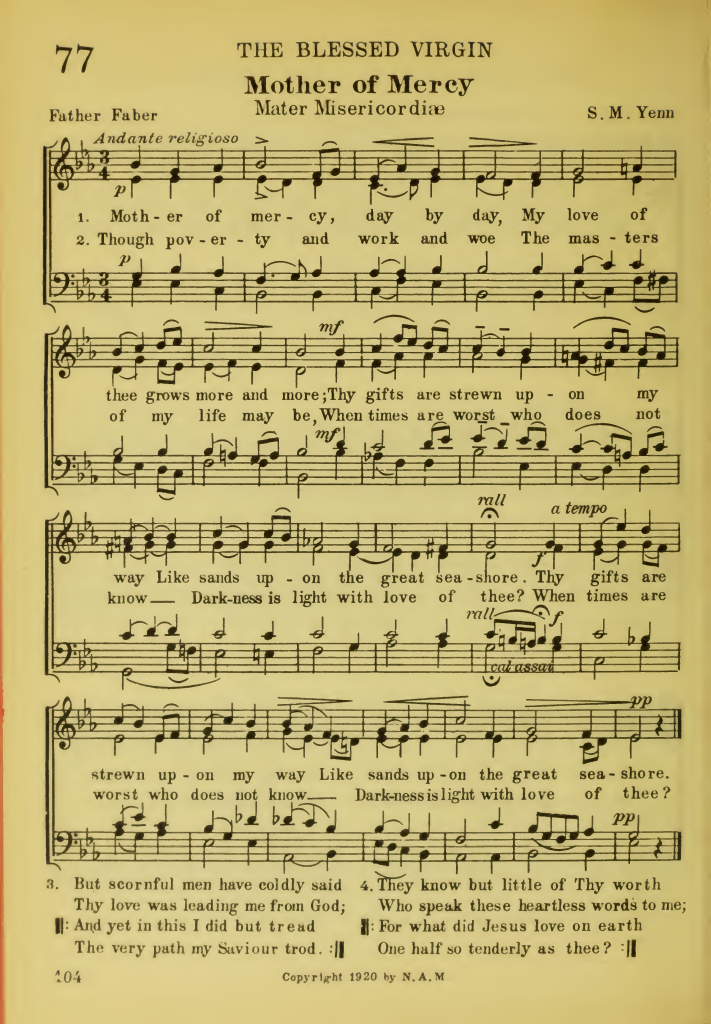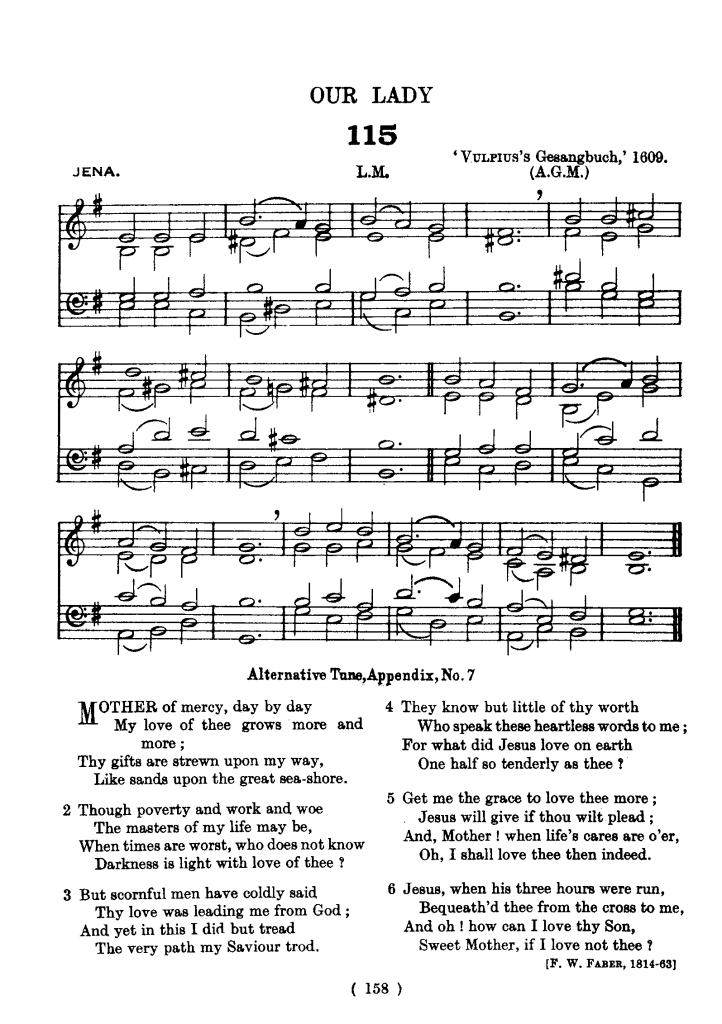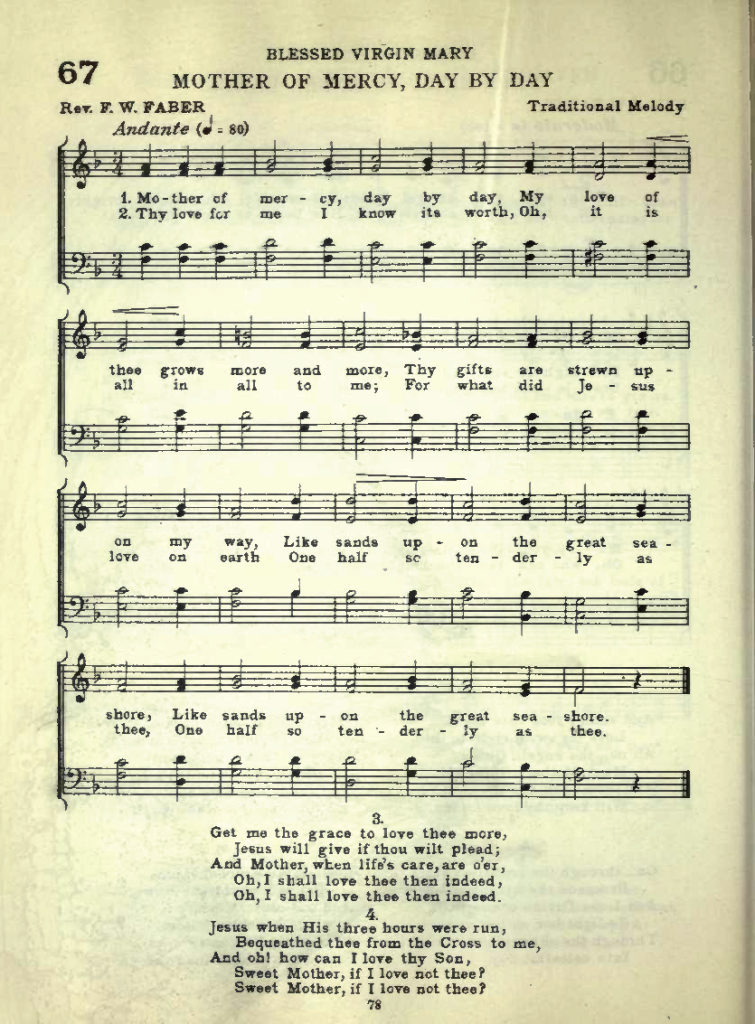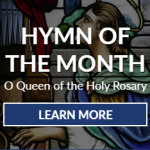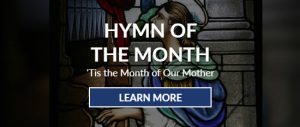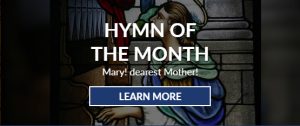Father Frederick William Faber (1814-1863) wrote the text of this hymn. He was a convert to Catholicism and was received into the Catholic Church on November 18, 1845, by Bishop Wareing, the first Roman Catholic Bishop of the Diocese of Northampton. He made his first communion and in confirmation he took the name of his patron St. Wilfrid. He began writing hymns in 1848 and wrote his first two hymns while on a retreat in Yorkshire in the small sea-side town of Scarborough. These were Mother of Mercy, Day by Day and Jesus, My Lord, My God, My All.
These first hymns and the few that followed where published in his JESUS AND MARY hymnal of which there were more than 1,000 copies sold by 1849. Father Faber wrote more than ninety hymns, some of them we still sing today including Faith of our fathers, living still; Jesus, My Lord, My God, My All; Dear Angel Ever at my Side; Dear Guardian of Mary; Like the Dawning; O Come and Mourn With Me Awhile, and There’s a wideness in God’s Mercy. He authored several books including All For Jesus; The Precious Blood; The Blessed Sacrament, and Growth In Holiness.
There is so much that I could write about Father Faber and his journey from Calvinism to Anglicanism and finally to Catholicism, but this would be a lengthy endeavor and is beyond the scope of this short write-up. However, it is worth mentioning a little something, call it a summary, of his journey to the Catholic Church.
As a young man Frederick Faber showed a natural prowess of poetry. This poetical element was developed during his boyhood and in the countryside of his youth (Westmoreland, Yorkshire, and Ambleside. Ambleside is a town that sits on the east side of the northern headwater of Windermere, England’s largest natural lake.) and where he spent much of his school days (the Grammar School of Bishop Auckland, Kirkby Stephen in Westmoreland until 1825, Shrewsbury School and then Harrow School) until he graduated to Oxford. He enrolled at Oxford University beginning in 1832 and was accepted to Balliol College one of the constituent colleges of Oxford and took up residence in the Lent Term of 1833 which was during the great Oxford Movement.
By his second year at the university his religious views began to undergo a change. Suffice is to say he rejected the teachings of Arminianism and all Calvinism (that God predestines people by choosing who will accept his salvation and that Christ suffered only for the elect of God, the chosen) and became a zealous advocate of Anglican principles. There are expressions found in his letters to his brother, friends and colleagues that indicate he had some misgivings concerning the Anglican beliefs. Certain doctrinal questions that were brought forward as a result of the Oxford Movement began to stir in him including the Catholic teaching on transubstantiation. He didn’t know it then, but these inner murmurings and doubts would in time lead him to the Catholic Church. It is also here that he became an enthusiastic admirer of Rev. John Henry Newman, vicar of St. Mary’s, although at this time he was not personally acquainted with him.
In 1835, Frederick Faber was chosen as a scholar of University College another of the constituent colleges of Oxford University. He desired earnestly to devote himself to the service of God and looked forward to a time when he could receive ordination as a minister in the Church of England. His election to fellowship at Oxford gave him a secure position and he set to work busying and preparing himself for orders. In August of 1837 he received deacon’s orders in the Church of England and was assigned to St. Wilfrid’s Cathedral of Ripon. In 1839 on the 26th of May he received priest’s orders and the Rectory of Elton, in Huntingdonshire, was offered to him by his college.
Shortly after accepting his duties as Rector of Elton he took a trip to the continent by way of France and then to Italy. He visited various cities in France and Italy when finally he arrived in Rome on May 9th, 1843. It is here that he acquired his devotion to St. Phillip Neri (1515-1595), the founder of the Oratorians. While in Rome he attended Ascension Thursday Mass in St. John Lateran’s church, the Pope’s cathedral. He was quite moved by the whole experience especially when Pope Gregory XVI descended from his throne and knelt before the foot of the altar. Mr. Faber left Rome on St. Alban’s Day (June 17) and traveled to Albano to spend a few quite days in the woods. Albano is about a twelve-hour ride from Rome in a horse drawn carriage.
Very ealry the next morning he received a letter that he was being summoned for an audience with the Pope at the Vatican Library at 5 P.M. that very day. He hurriedly set off to Rome in full dress and arrived at the Vatican Library and waited until the Pope arrived. Through an interpreter Frederick Faber and the Pope had a lengthy conversation which encompassed a few church matters but mostly his desires to join the Catholic Church.
The Pope said to him, You must not mislead yourself in wishing for unity, yet waiting for your Church to move. Think of the salvation of your own soul. He then laid his hands on Mr. Faber’s shoulders and blessed him with this prayer, May the grace of God correspond to your good wishes, and deliver you from the nets of Anglicanism, and bring you to the Holy Church. Frederick Faber left Rome greatly affected by the affectionate demeanor of this old Pope, his blessing, and his prayer. It was a day he would always remember.
He returned to his parish of Elton and the nearly one thousand parishioners, every day growing more and more Roman. For the next two years every expression of Catholic life answered a doubt or dispelled some fear and the words of the Holy Father to save his own soul weighed heavily upon him. By now many of his friends had already joined the Catholic Church and on November 16th, 1845, he officiated for the last time as Rector of Elton. Two days later he was received into the Catholic Church.
This brief account can hardly elucidate every happening, trial, and inward struggle of Father Faber’s conversion journey. You can learn more about this wonderful Catholic priest and his journey to Catholicism by reading his biography in The Life and Letters of William Frederick Faber, Priest of the Oratory of St. Philip Neri, published in 1869.
The Melodies:
The melodies that have been composed are attributed to several musicians including two melodies by Henri F. Hemy (1818-1888) found in the CROWN OF JESUS MUSIC published in 1864, of these two melodies one would become traditional to the hymn; a melody by Meyer Lutz (1829-1903) found in THE POPULAR HYMN AND TUNE BOOK published in 1868; a melody by W. C. Peters (1805-1866) found in PETERS’ CATHOLIC HARP published in 1895; a melody by John Richardson (1816-1879) found in Tozer’s CATHOLIC HYMNS published in 1898; a melody by Henry Baker (1835-1910) and a melody by Sir Alfred Scott Gatty (1847-1918) found in the ARUNDEL HYMNAL published in 1905; a melody by Sir Richard R. Terry (1865-1938) found in the WESTMINSTER HYMNAL published in 1912; a melody by a Marist Brother known only as B. M. J., found in the AMERICAN CATHOLIC HYMNAL published in 1913; a melody by Father Simon M. Yenn (1863-1938) found in the ST. GREGORY HYMNAL published in 1920; and a melody from Melchior Vulpius’s Gesangbuch of 1609 found in the WESTMINSTER HYMNAL published in 1939.
Henri (Henry) F. Hemy was born in 1818 Newcastle, England. He was the organist at St. Andrew’s Church in Newcastle and later professor of music at St. Cuthbert’s College now Ushaw College in Durham. He sang baritone and painted artwork. He composed more than seventy different works of music including waltzes, polkas, hymns and set most of Longfellow’s works to music. He compiled two hymn collections including EASY HYMNS AND SONGS, 1851 and CROWN OF JESUS MUSIC, 1864.
Meyer Lutz (Wilhelm Meyer Lutz) was a German born English organist. He was a composer and conductor known for his work touring with theater companies. He composed several operas and was the musical director of the Gaiety Theater in London’s West End. He was also the church organist in Birmingham, Leeds, and London. His father was Joseph Lutz (1801-1879), a music professor who introduced music to his son in the 1830s.
William Cummings Peter was born in England and he came to Texas in 1820. During the years 1826-1828 he gave piano lessons in Pittsburgh, Pennsylvania. In 1829, he opened a music store in Louisville, Kentucky and another in Cincinnati, Ohio. Peters’ Catholic Harp was first published in 1863. Hymnals and other musical publications by the firm Peters’ in Cincinnati were extremely popular in the 1880s.
John Richardson grew up a choir boy at St. Mary’s Church, Liverpool, and later organist for St. Nicholas Church for twenty years. He taught music at St. Edward’s College and Upshaw and retired to Preston. He was admired by Cardinal Newman and honored by Pope Pius IX. He composed the melodies for the following hymns including By the Blood that flowed from Thee; Jesus, ever loving Savior; Come Holy Ghost, Creator Come; Sweet Mother, turn those gentle eyes; Look down, O Mother Mary; Hail, bright Star of Ocean, God’s own Mother; Mother of Mercy, Day by Day; and several others.
Henry Baker composed the first tune found in the Arundel Hymnal of 1905. Henry Baker was a civil engineer building railroads in India. He was however musically inclined and completed a music degree at Exeter College, Oxford in 1867. He composed this tune known as Hesperus, Quebec, and Elim while a student at Exeter College.
Sir Alfred Scott-Gatty composed the second tune found in the Arundel Hymnal. He was a composer of children’s music and a few operettas. His collection of Little Songs for Little Voices was published in three volumes. He also was an officer of arms at the College of Arms in London and was knighted for his services in 1911.
Sir Richard R. Terry composed the melody found in the Westminster Hymnal of 1912. He was educated at King’s College, Cambridge and joined the Catholic Church in 1896. He was choirmaster and organist at the Westminster Catholic Cathedral from 1901-1924, and the editor of the Westminster Hymnal published in 1912. He was knighted in 1922.
Little was known about the Marist Brother B. M. J., except that he composed more than fifty of the hymns found in the AMERICAN CATHOLIC HYMNAL. Recently, the archivist for the Marist Brothers revealed to me that B. M. J. was a pseudonym for Brother Zephiriny. It was a customary practice in those days that an individual Brother’s name could not be used in a publication or in a musical composition without the expressed permission of the Brother Provincial. The Marist Brothers of the Schools of New York compiled the hymnal, and it consisted of Hymns, Latin Chants, and Sacred Songs for Church, School, and Home. There were two editions of the hymnal published by P. J. Kenedy & Sons of New York. The first was published in 1913 and the second edition was published 1921. Brother Zephiriny was one of the outstanding leaders of the U.S. province from 1892 until his death in 1928.
Father Simon Yenn served on the Music Committee for the Society of St. Gregory and was the Diocesan Director of Sacred Music for Ft. Wayne, Indiana. He composed the melodies for three hymns found in the ST. GREGORY HYMNAL published in 1920. Why art thou sorrowful? Mother of Mercy, and Hail Virgin, dearest Mary (Queen of May). He was a contributor to the Catholic Choirmaster magazine from 1915 till 1923 and wrote a series of articles on Church Music Reform.
Melchior Vulpius was a German composer and schoolmaster. He was a prolific composer and during his lifetime one of the most important contributors of Lutheran hymn tunes in Germany. He has two hundred motets and some four hundred hymns to his credit. He compiled several hymn collections and published several Sacred Vocal works both in Latin and German. The music was arranged by DOM Gregory Murray, O.S.B., a student of Sir Richard Terry.
Reflection
The arrangement I learned to sing in St. Mary’s Choir (1977-2010) which is the traditional melody comes from the ST. BASIL’S HYMNAL, 1918. The choir would sing this hymn before Mass on many occasions as a prelude and especially for the Feast of Our Lady of Mercy, September 24. At St. Mary’s we had a custom of singing a hymn the weekend before to remind parishioners that a feast day was fast approaching. Every so often the feast day would fall on Sunday which makes singing the hymn ever more appropriate.
The first verse of the hymn is quite moving and expresses the love many Catholics have toward Our Lady. The words, Thy gifts are strewn upon my way, Like sands upon the great seashore, are constant reminders to me of the many gifts we have received from Our Lady in our struggle against the wily snares of Satan. These include the Rosary, the Miraculous Medal, the Brown Scapular, the many invocations, prayers, and Church dogmas. What gifts of Our Lady have you found along your way that have helped you?
The last verse touches me deeply. Father Faber writes, Jesus, when His three hours were run, Bequeath’d thee from the cross to me, reflecting on John’s gospel (Jn. 19:26-27) where Jesus says to his mother from the cross, Woman, behold your son and to John, behold your mother. This hymn is by far one of my most favorite Catholic hymns and one that often times will spontaneously surface in my memories. I sing along with my friends of St. Mary’s Choir who precede ahead of me to that heavenly glory.
I want to thank Peter Meggison, producer of The Devotional Hymns Project for granting permission to link to a newly commissioned recording by the St. John Cantius Church, Chicago. Click on the link to hear this beautiful recording which includes all the verses from Father Faber’s 1849 hymn Mother of Mercy, Day by Day.
Below is a selection of the melodies listed above which have been composed for the hymn. These are computer generated sound files. The tempo is approximate but should provide the listener a good sense of what the hymn sounds like. All the hymns are in the public domain. Church musicians, if you use any of these selections in your Sunday or weekly music programs and you make a recording and you are willing to share, contact the author and I will feature it in the What’s New section of my website.

